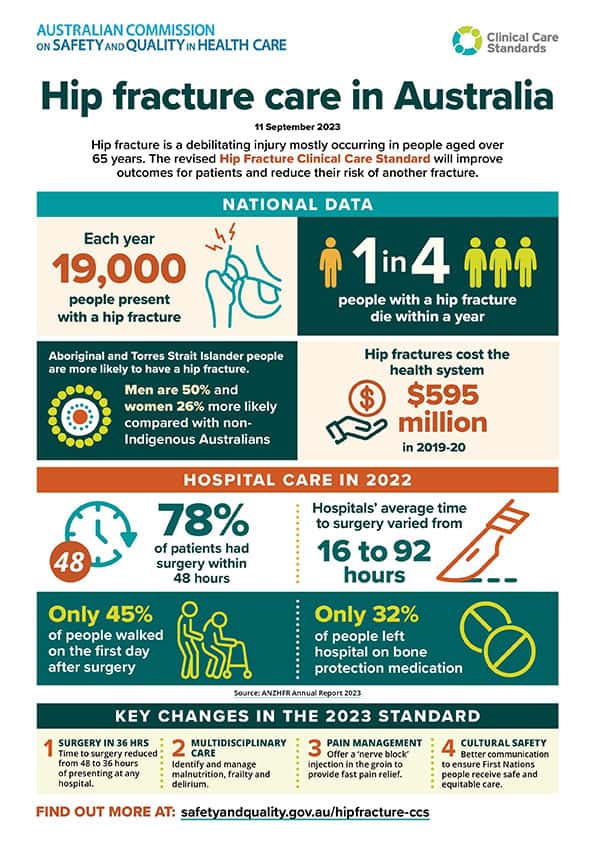Undergoing surgery for a hip fracture as soon as possible is critical to survival, new data has revealed.
The outlook emerges from an updated Hip Fracture Clinical Care Standard, launched today by the Australian Commission on Safety and Quality in Health Care at the binational Hip Fest 2023 conference.
The updated standard reduces the recommended maximum time to surgery from 48 to 36 hours – along with other improvements for better care – and will aim to drive meaningful change as hospitals establish protocols to meet the targets.

According to the Australian Institute of Health and Welfare (AIHW), every year in Australia, 19,000 people fracture their hip, usually after a fall. Most hip fractures happen to people over 65 years and are often a life-changing event.
Hip fracture significantly increases an older person’s risk of death, with one in four people dying within 12 months after a hip fracture injury. Of those who survive, many lose their ability to live independently or return to their former lifestyle.
The updated Hip Fracture Clinical Care Standard (2023) for hospitals has reduced the maximum time to surgery from 48 hours to 36 hours, in line with international guidelines. For the first time, this explicitly includes patients who need to be transferred to a hospital that can perform the surgery.
The Commission’s Acting Chief Medical Officer, emergency physician Associate Professor Carolyn Hullick, said there was an urgent need for health services to offer better care for people with a hip fracture, using the framework in the updated standard.
“Anyone who has seen someone live through a hip fracture knows it’s much more than a broken bone. People with a hip fracture tend to be older, frail and more vulnerable, so it is critical the fracture is repaired quickly to reduce pain and get them on the road to recovery back to independence,” she said.
“The data is sobering, as an Australian with a hip fracture is almost four times more likely to die within a year than someone of the same age who isn’t injured. This has an immense personal toll on individuals and families, in addition to the burden on our health system of around $600 million each year.”
Much has improved since the Hip Fracture Clinical Care Standard was introduced in 2016, according to ANZHFR annual reports. The ANZHFR contains around 90,000 records, with 91% of hospitals performing hip fracture surgery in Australia participating to help improve their hip fracture care.
While some hospitals have substantially reduced their time to surgery, there is still marked variation. In 2022, the average time to surgery ranged from 16 to 92 hours, with the longest waiting times for people being transferred for surgery. About 78% of patients had surgery within 48 hours.
Geriatrician Professor Jacqueline Close, Co-Chair of the ANZHFR and Co-Chair of the expert advisory group for the standard, believes the updated standard will be a lever for change.
“The Hip Fracture Clinical Care Standard sets expectations for how every patient should be cared for, while allowing for treatment to be tailored to the individual,” she said.
“The adage ‘don’t let the sun set twice before hip fracture repair’ has merit for several reasons. Firstly, no-one wants to see their mum or dad fasting and in pain waiting for surgery; and shorter time to surgery is associated with fewer complications, better recovery and survival.
“It is also more cost efficient to manage these patients well. Every day surgery is delayed, two days are added to the length of stay. The sooner you operate, the quicker patients can get walking and go home.”
More information here








